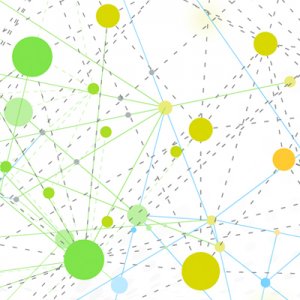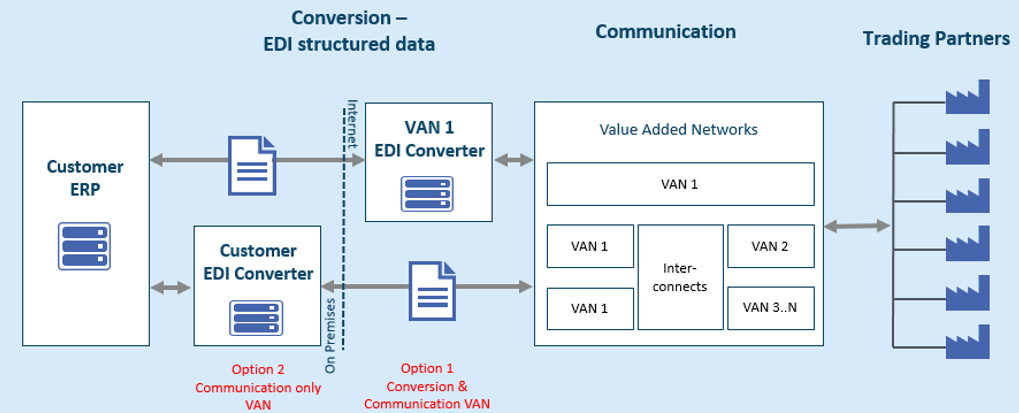Your EDI Supply: Remain Indirect or Switch to Direct? Issues and Benefits businesses should consider
EDI (Electronic Data Interchange) is often mandated as part of a trading partner relationship between suppliers and buyers. This type of digital connectivity is crucial for the level of productivity and agility businesses need to thrive in today’s competitive markets. But how to best go-about utilizing that digital connectivity with EDI?…
is often mandated as part of a trading partner relationship between suppliers and buyers. This type of digital connectivity is crucial for the level of productivity and agility businesses need to thrive in today’s competitive markets. But how to best go-about utilizing that digital connectivity with EDI?…
There are two fundamental approaches embracing EDI:
- Indirect connections to trading partners that are managed by an EDI VAN (Value Added Network) provider via mailboxes, or
- Direct connections to trading partners that either are self-managed (on-premises) or outsourced (as a managed service).
Let’s consider these two approaches…
What is an EDI VAN? (Indirect Connections)
An EDI VAN is a provider of connections as a service over a secure, outsourced network. VANs simplify EDI setup, and simplify communication and exchange of EDI documents by reducing the number of directly involved parties.
EDI VANs emerged back in the 1980’s when direct connections over the Internet were too expensive and unstable. VANs use a concept of electronic mailboxes that needed polling on a regular basis to check for new messages. EDI VAN providers have agreements to transfer data between them through interconnects so that trading partners, who use different VAN entry points, are able to exchange data.
Some VANs expect the EDI documents to be correctly formatted and thus focus purely on routing files to trading partners (posting to electronic mailboxes). Other VAN providers handle the mapping of EDI data structures and offer the conversion of documents as a cloud service (in addition to routing the files). Figure 1 depicts both options of a typical EDI VAN setup.

While getting started with an EDI VAN is easy, there are some technical and business issues with this approach:
Four Key Issues with an EDI VAN Service:
- Manual implementation. On-boarding new trading partners is tedious and time consuming when performed manually. Onboarding becomes problematic when adding multiple new partners by copying data from spreadsheets or typing it into a web portal one-by-one. In the instance where mappings are required, the implementation becomes even more cumbersome. Rapid scaling is a requirement for businesses to thrive.TIP: Avoid EDI VAN service providers with off-shored mapping factories and look for solution providers offering automated onboarding to drastically reduce the time and effort required.
- Maintenance and Reliability. VAN service outages are a reality. When a VAN solution fails, your business risks SLA fines, chargebacks, and loss of revenue with your entire Trading Partner Community.Maintenance also requires a great deal of repetitive effort as configurations inevitably change over time.
- Operational Challenges. Using a VAN service also comes with operational issues that impact visibility into the status of communication. The feedback status as required by the store-and-forward principle is non-existent, and thus it’s unclear when the partner can actually retrieve their files. This causes unnecessary and inefficient polling by the partner. VAN services also lack a management and tracking tool for those who need visibility into the communication exchange. This problem is compounded if trading partners use different VANs that require costly interconnects.
- Mailbox Workarounds Lead to More Costs. With larger transaction volumes, EDI costs tend to escalate significantly. Many VANs also demand supplemental fees if transaction volumes are exceeded. Using interconnects between disparate VANs to avoid additional mailbox costs leads to more operational challenges. Guaranteed processing times are measured in hours, not minutes. Adding interconnects per VAN product accrues as your business adds partners. The additional cost doesn’t guarantee files will be transmitted or when they will be transmitted – as no SLAs are given.
Read about the EDI Mapping Approach: Why Direct Mappings Don’t Make Sense in our Blog.
What is a Direct EDI Connection?
On premises software or cloud solutions for EDI provide direct EDI connections without the service cost for a ‘middle-man’ by using openly available secure IPs (Internet Protocols) such as OFTP2, AS2 and others based on certificates. These direct solutions scale from comparably small numbers of trading partners and low volumes to complex EDI workflow, mapping and communication on an enterprise level. A topic to consider is the handling of signed certificates which require effort. Look for offerings based on smart concepts to minimize this. Figure 2 depicts a typical direct EDI connection setup.

Four Key Benefits of Direct Connections for EDI:
- Quality and Speed: Direct IP connections for EDI provide full control as changes can be made in-house or by the cloud provider. Comprehensive EDI cloud providers also offer an iPaaS option. This way on-boarding partners enabling new business, is measured in days and not months (as is the case with a VAN service).
- Overall Cost is Much Lower: Direct IP connections for communication are significantly less costly when large numbers of transactions are involved.
- Comprehensive Partner Support: State-of-the-art EDI solutions support all format and communication standards of protocols. In today’s hyper-connected world, and with Industry 4.0 on the rise, direct connections will prevail increasingly. Additionally, connections with trading partners who want to stay on legacy VANs for the time being can be provided. Comprehensive EDI solution and cloud providers offer options for a handover point if trading partners still insist on communicating via a VAN mailbox.
- Greater Automation and Flexibility: Modern EDI solutions integrate with backend systems: ERP, CRM, and accounting tools. The error-prone manual data reentry process is all but eliminated. Modern EDI solutions also integrate APIs, IoT/Industry 4.0, Managed File Transfer etc. and have the potential to be used as hybrid integration platforms.
Summary
If you’re currently operating on an indirect EDI VAN service, you are probably experiencing the majority of the four key issues outlined above. These can be easily resolved by switching to a more robust direct EDI communication platform. Those who employ direct connections to their trading partners over AS2 or OFTP2 with an on-premises or cloud solution will leverage many additional advantages over their competitors who choose to remain with an indirect EDI VAN service.
Watch How to Reduce EDI VAN Costs whilst Leveraging a Better B2B/EDI Service in our Webcast on Demand
Thank you for your message
We appreciate your interest in SEEBURGER
Get in contact with us:
Please enter details about your project in the message section so we can direct your inquiry to the right consultant.
Written by: Ian Goldsmith
Ian Goldsmith is Business Development Director at SEEBURGER, a global market leader in business integration software. With ~25 years integration experience spanning development, consultancy management, pre-sales, solutions management, account management and marketing, he is well versed in understanding integration requirements of today (and tomorrow) from all angles. Ian, has utilised his industry and technical knowledge to brief Industry Analysts and ‘C’ level execs on numerous occasions, and has won awards along the way for outstanding work with clients.





